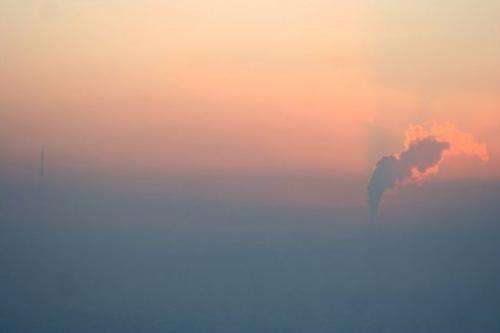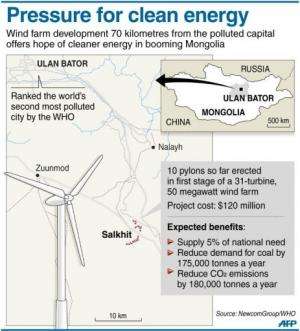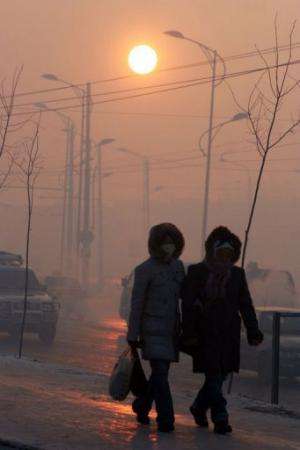Answer to Mongolia pollution is blowing in the wind

Mongolia's economic boom has been built on the vast coal reserves that lie under its seemingly endless steppes, but it is turning to wind to power itself and fight the pollution that chokes Ulan Bator.
The Mongolian capital is ranked the planet's second most polluted city by the World Health Organization, largely due to its coal-fired power stations and residents burning the substance to keep warm in winter, when temperatures can plummet to a punishing minus 30 degrees Celsius (minus 4 Fahrenheit).
But in Salkhit, around 70 kilometres to the southeast, 10 pylons rise from the ground, the first stage of a 31-turbine, 50 megawatt wind farm its backers hope will start a national drive to harness cleaner energy.
The $120 million project may appear incongruous in a country said to have more than $1 trillion worth of untapped resources underground, especially coal, but Mongolia's windy steppes could offer an endless supply of power.
The concept also connects with deeply-rooted elements of Mongolian culture—Genghis Khan's warriors used to worship the Eternal Blue Sky.
"We have a longstanding tradition of being environmentally friendly in Mongolia," said Bayanjargal Byambasaikhan, CEO of Mongolian investment firm Newcom, which is backing the wind farm.
"We are a nomadic people, people who move from one place to another and take with us all our waste and belongings," he told AFP.
Once operational the farm at Salkhit, or "Windy Mountain" in Mongolian, will supply five percent of the country's current electricity needs—and his ambitious plans aim to increase wind capacity several times over.
But he has faced scepticism along the way. "When we started with this wind farm project eight years ago many thought that we did not know what we were doing," he said.
"Mongolia's name is really on the world map now because of resources that are in the ground: coal, copper and iron ore. Why would you invest in wind power in Mongolia, a country which has an abundance of coal resources?

"But I am advocating clean energy, because Mongolia has one of the best resources in the world in terms of wind."
Ulan Bator's one million residents will be among the first to benefit from the new energy source, according to Byambasaikhan, who says the Salkhit project will reduce demand for coal by 175,000 tonnes a year.
During the winter, dense, grey clouds of smog often linger for days in the city, which lies in a narrow valley, and pollution is six to seven times higher than even the most lenient WHO standards.
The organisation ranks the Iranian city of Ahvaz as the world's most polluted city in terms of airborn particles.
In Ulan Bator, the city's three coal-fired power plants are one of the main causes, plus residents of the poor outlying "ger" districts—named for the nomads' tents used for housing—burning coal, tyres and rubbish as a heat source in the harsh winter.
The areas' population has ballooned in recent years, as more nomads arrive in Ulan Bator to seek a share of Mongolia's new-found wealth.
"In the winter, the air in Ulan Bator is really nasty. You cannot see for 100 metres in the worst times," said Kirk Olson, an environmentalist who has worked in Mongolia for 12 years.

"When you fly out of there you see this big grey, impenetrable fog in the valley. People are burning garbage and using banned diesel. There are big power stations pumping pollution into the air."
The US-backed Millennium Challenge Corporation aid agency has backed a $45 million project it says has cut fuel costs by 30 percent in 70,000 households, and the Mongolian government launched a range of measures, including taxing inefficient cars.
But even Mongolian President Tsakhiagiin Elbegdorj acknowledged that piecemeal measures will only have a minimal impact.
"For the first time last year we had an anti-pollution law that ensures we are not encouraging those who are polluting the environment and creating smoke," he told AFP.
"We have this kind of system in place but it is not sufficient, and is only the beginning."
So far anti-pollution measures have done little to restore clear air over the city, say environmentalists.
Olson said the issue was "much bigger" than the government recognised. "It is not just about people burning garbage in the ger districts. It is not just about the police pulling over a car with blue diesel coming out of the exhaust.
"There has been nothing that really tackles it. Just small fiddling with the problem."
(c) 2012 AFP




















